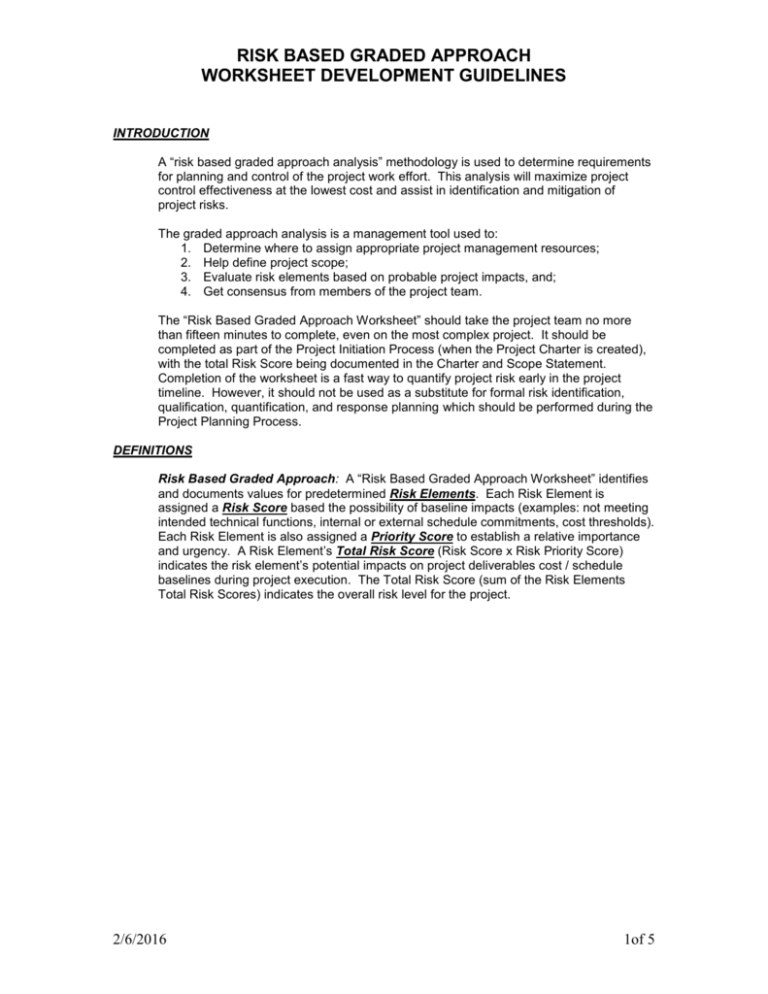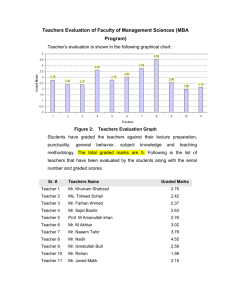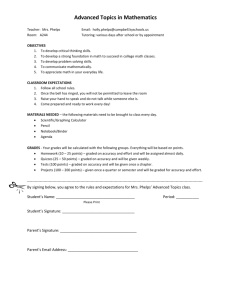Risk Based Graded Approach Guidelines
advertisement

RISK BASED GRADED APPROACH WORKSHEET DEVELOPMENT GUIDELINES INTRODUCTION A “risk based graded approach analysis” methodology is used to determine requirements for planning and control of the project work effort. This analysis will maximize project control effectiveness at the lowest cost and assist in identification and mitigation of project risks. The graded approach analysis is a management tool used to: 1. Determine where to assign appropriate project management resources; 2. Help define project scope; 3. Evaluate risk elements based on probable project impacts, and; 4. Get consensus from members of the project team. The “Risk Based Graded Approach Worksheet” should take the project team no more than fifteen minutes to complete, even on the most complex project. It should be completed as part of the Project Initiation Process (when the Project Charter is created), with the total Risk Score being documented in the Charter and Scope Statement. Completion of the worksheet is a fast way to quantify project risk early in the project timeline. However, it should not be used as a substitute for formal risk identification, qualification, quantification, and response planning which should be performed during the Project Planning Process. DEFINITIONS Risk Based Graded Approach: A “Risk Based Graded Approach Worksheet” identifies and documents values for predetermined Risk Elements. Each Risk Element is assigned a Risk Score based the possibility of baseline impacts (examples: not meeting intended technical functions, internal or external schedule commitments, cost thresholds). Each Risk Element is also assigned a Priority Score to establish a relative importance and urgency. A Risk Element’s Total Risk Score (Risk Score x Risk Priority Score) indicates the risk element’s potential impacts on project deliverables cost / schedule baselines during project execution. The Total Risk Score (sum of the Risk Elements Total Risk Scores) indicates the overall risk level for the project. 2/6/2016 1of 5 RISK BASED GRADED APPROACH WORKSHEET DEVELOPMENT GUIDELINES RISK ELEMENT FDOT’s pre-determined risk areas (15) developed by the project management office from experience on numerous projects: 1 - UTILITY INVOLVEMENT – defines what degree of involvement will be faced by the project team in executing the project. 1 – None or very little impacts; no relocations 3 – Small number of utilities in the corridor with minor adjustments and few relocations 5 - Multiple utilities with major relocations 2 - PROJECT SCHEDULE – defines how much time the project team has to complete the schedule. 1 – Everyone has as much time as they want. 3 – The schedule is somewhat compressed. 5 – The schedule is very compressed or very critical 3 - INTERFACES – defines how many organizations are involved in project planning and/or execution. 1 – one to three 3 – four to seven 5 – greater than seven 4 - EXPERIENCE/CAPABILITY – defines the level of experience and capability of project team members. 1 – project loaded with heavyweights 3 – a blend of heavyweights and inexperienced personnel 5 – project loaded with inexperienced personnel 5 – RIGHT OF WAY (ROW) INVOLVEMENT – identifies level of ROW acquisition involved. 1 – No ROW required 3 – Minor ROW required, such as corner clips 5 – Major ROW acquisition with redesigns for cures 6 - ENVIRONMENTAL IMPACTS/CONTAMINATION – defines the level of environmental contamination encountered. 1 – None or minor environmental impacts; contamination fully characterized and acceptable 3 – Major, but routine impacts that are readily permitted; contamination partially characterized and results indeterminate 5 – Extensive major impacts that are difficult to permit and will cause delay; contaminations expected; extent unknown or unacceptable characterization 7 - REGULATORY INVOLVEMENT – identifies the degree that governmental or other regulatory agencies impact the project. 1 – none or minor involvement 3 – somewhat involved 5 – regular contact and/or visits 2/6/2016 2of 5 RISK BASED GRADED APPROACH WORKSHEET DEVELOPMENT GUIDELINES 8 - CONTRACTOR ISSUES – defines the degree of complexity that is expected (e.g., long lead time items, contractor qualification, vendor reliability) 1 – minor or non-existent issues 3 – Contractor issues on a regular basis, but manageable 5 – Contractor issues may result in significant schedule delays and/or cost overruns 9 - RESOURCE AVAILABILITY – defines the availability of internal and external resources to plan and execute the project. 1 – Resources/materials readily available 3 – Resources/materials somewhat restricted 5 – Resources/materials constrained, impacting schedule and cost 10 - PROJECT FUNDING – defines availability and approval status of project planning and execution funds. 1 – Single source and approved 3 – Multiple source and approved 5 – Significant chance that funding may be cut or inadequate to continue the project 11 - POLITICAL VISIBILITY – Indicates the level of exposure the project has to elected officials. 1 – None - just get it done 3 – Somewhat visible – provide occasional updates or receive occasional calls from elected officials 5 – Very involved – scheduled visits by and frequent updates to elected officials or their designated staff 12 - PUBLIC INVOLVEMENT – indicates how much the public is involved in the project 1 – None – just get it done; public behind the project with little opposition 3 – Somewhat involved – issue news releases as required; some opposition but not very organized 5 – Very involved – representative(s) part of project scope, schedule, cost, and quality decisions; strong, well organized, vocal public opposition 13 - SAFETY – defines the safety issues the project team will encounter while completing the project. 1 – standard safety considerations 3 – increased diligence due to location, product weight or configuration, or type of work (e.g., high voltage) 5 – very restrictive safety considerations (e.g., caustic environment, hot-taps, etc.) 14 - CONSTRUCTION COMPLEXITY – defines the degree of complexity that can be expected when combining technology, scope of work, maintenance of traffic and schedule. 1 – Rural environment; routine daytime construction with limited night work; 3 – Major construction in rural or suburban environment; construction operations not constrained by right of way width 5 – Project in urban environment; involves new construction techniques; multiple phased project with complex maintenance of traffic; construction operations constrained by tight right of way width 2/6/2016 3of 5 RISK BASED GRADED APPROACH WORKSHEET DEVELOPMENT GUIDELINES 15 - WEATHER SENSITIVITY - defines how weather conditions, major events (hurricanes for example), and time of year would impact the project 1 – No impact by normal weather or a major weather event 3 – Little impact by normal weather; some impact by a major weather event 5 – Major impact by either a normal weather disruption or a major event; time of year significantly constrains progress (for example, aerial photography difficult to obtain in summer due to cloud cover) RISK ASSESSMENT The “Risk Assessment” value is determined by the project team and documented on the graded approach worksheet. The below-listed guidelines can be used to guide the team members in determining the overall level of risk, per element, to project priorities (i.e., scope, schedule, cost, and, quality). Risk assessment values are recorded as follows: 1 – low risk 3 – medium risk 5 – high risk RISK PRIORITY The project team identifies where they will apply priorities within the identified risk elements. 1 – low priority 3 – medium priority 5 – high priority (three maximum) The team determines where to assign the three each “5’s” (i.e., highest priority) and scores the balance with either a “3” (medium priority) or “1” (low priority). IMPORTANT: Experience/Capability and Safety should NEVER be a priority 1 (low priority) because it sends a wrong message). TOTAL SCORE The Total Score is calculated by multiplying the scores in the risk assessment column times the priority scores for a total per risk element. The risk element scores are then summed to determine a “Total Risk Score”. INTREPRETING THE GRADED APPROACH WORKSHEET Two values should be examined: The project’s Risk Score indicates where it fits into specified ranges for low, medium, or high risk. The “5 X 5” (5 in both the risk assessment and risk priority columns) – A “5 X 5” for a single risk element signifies a risk element that should be focused on by the team and used to determine the makeup of team members. For example, for a “5 X 5” in Project Schedule would suggest need for a schedule focused leader, whereas a “5 X 5” in Construction Complexity would suggest need for more of an engineering focused leader. NOTE: These 15 elements have been determined to be applicable to the majority of FDOT’s projects. However, some elements may not be applicable to some projects and it may also be appropriate to add elements to some other projects). An example Risk Based Graded Approach Worksheet is on the following page. 2/6/2016 4of 5 RISK BASED GRADED APPROACH WORKSHEET DEVELOPMENT GUIDELINES ITEM RISK ELEMENT RISK ASSESSMENT PRIORITY TOTAL 1 Utility Involvement 1 3 3 2 Project Schedule 5 5 25 3 Interfaces 3 1 3 4 Experience/Capability 3 3 9 5 Right of Way 3 1 3 6 Environmental Impacts/Contamination 3 1 3 7 Regulatory Involvement 1 1 1 8 Contractor Issues 3 3 9 9 Resource Availability 5 3 15 10 Project Funding 1 1 1 11 Political Visibility 3 5 15 12 Public Involvement 3 3 9 13 Safety 3 3 9 14 Construction Complexity 1 1 1 15 Weather Sensitivity 5 5 25 Risk Score 137 Risk Score = 0-90 Risk Score = 90-150 Risk Score = >150 Low Risk Medium Risk High Risk Note: The maximum Medium Risk score (150) is ten times the number of risk elements (15) and the maximum Low Risk score is 60% thereof. If the number of elements is reduced or is increased the maximum Medium Risk score and the maximum Low Risk score should be adjusted accordingly. Also, for every three additional risk elements over 15, allow one additional Priority 5 score. 2/6/2016 5of 5





